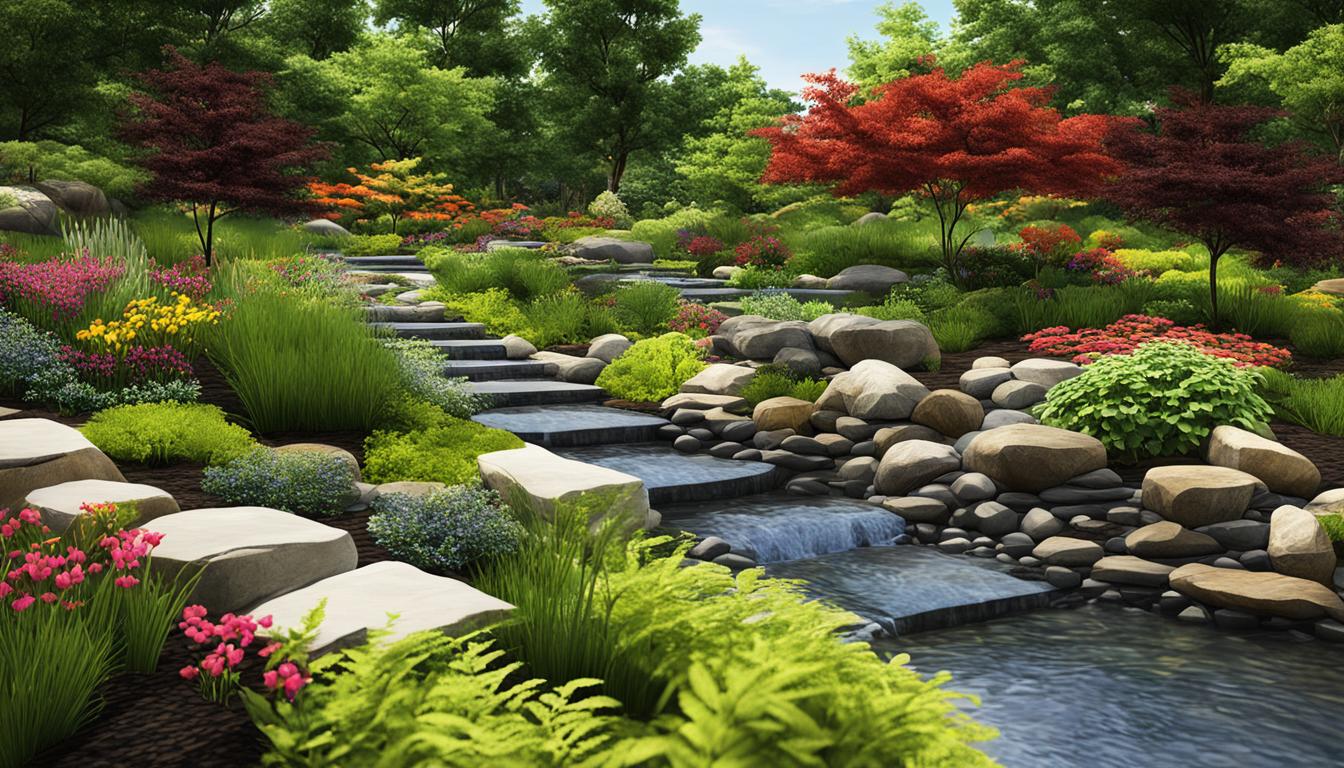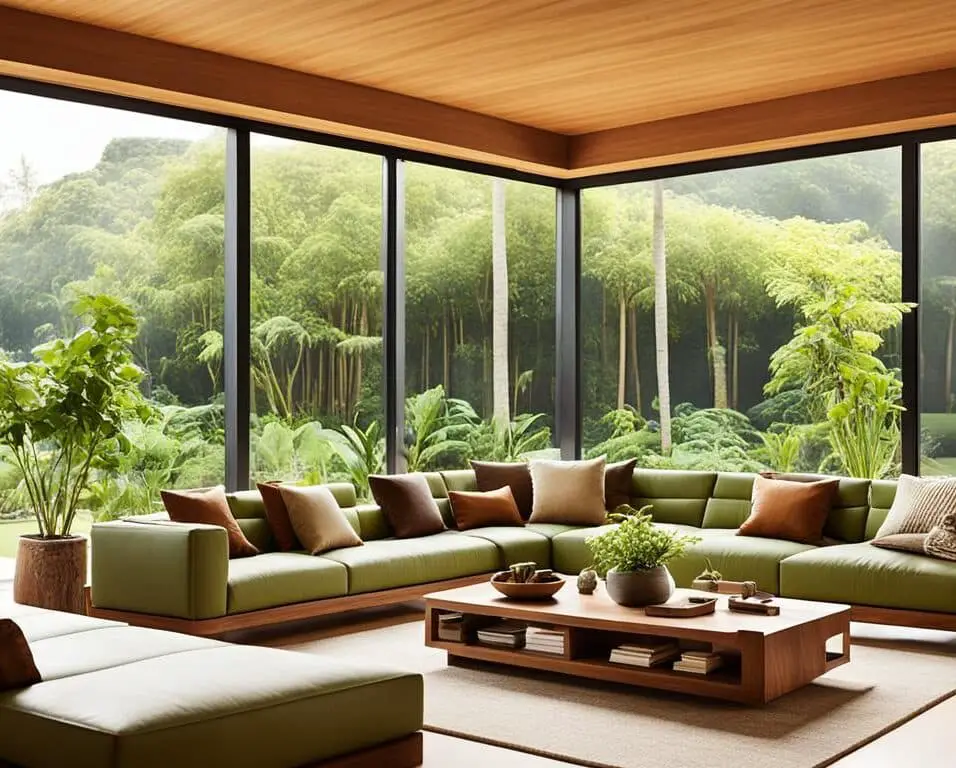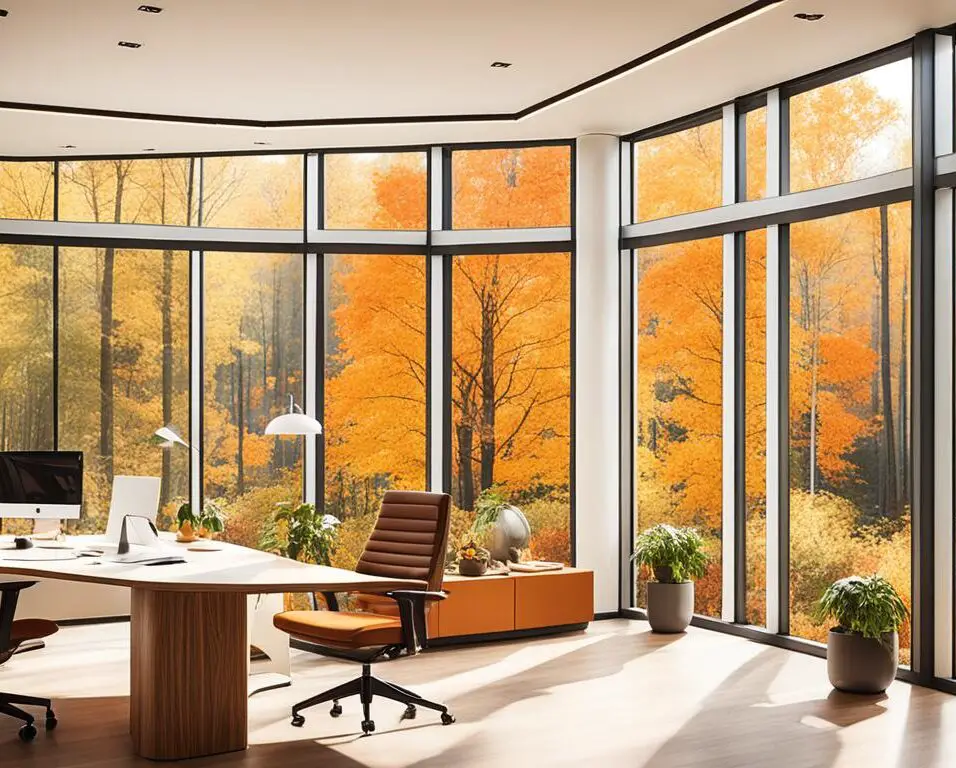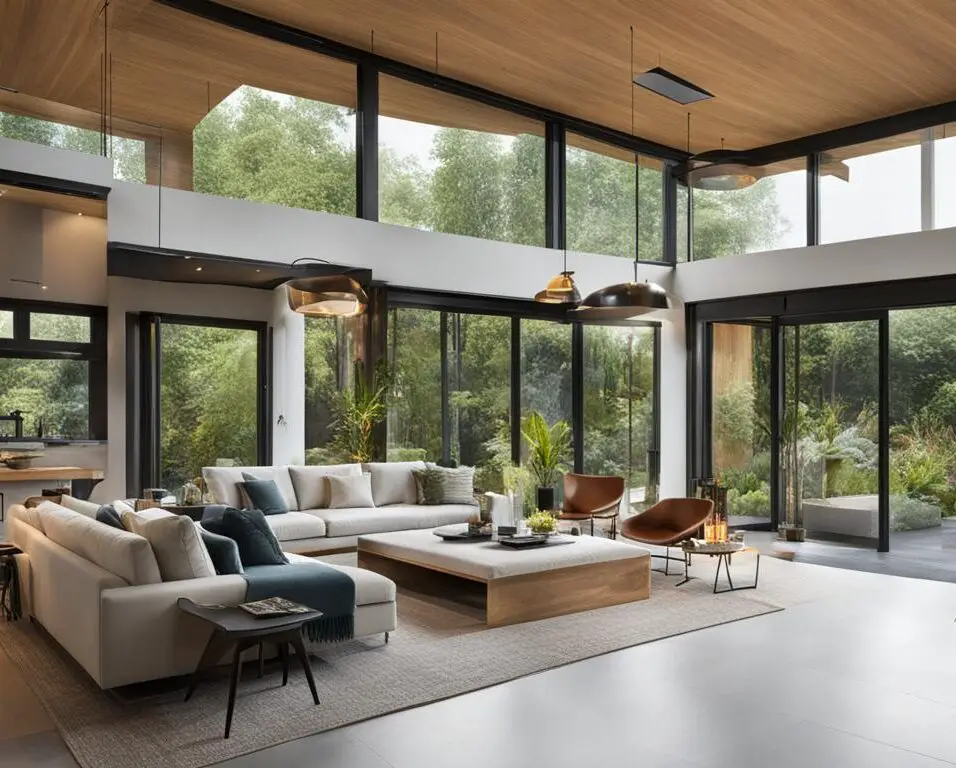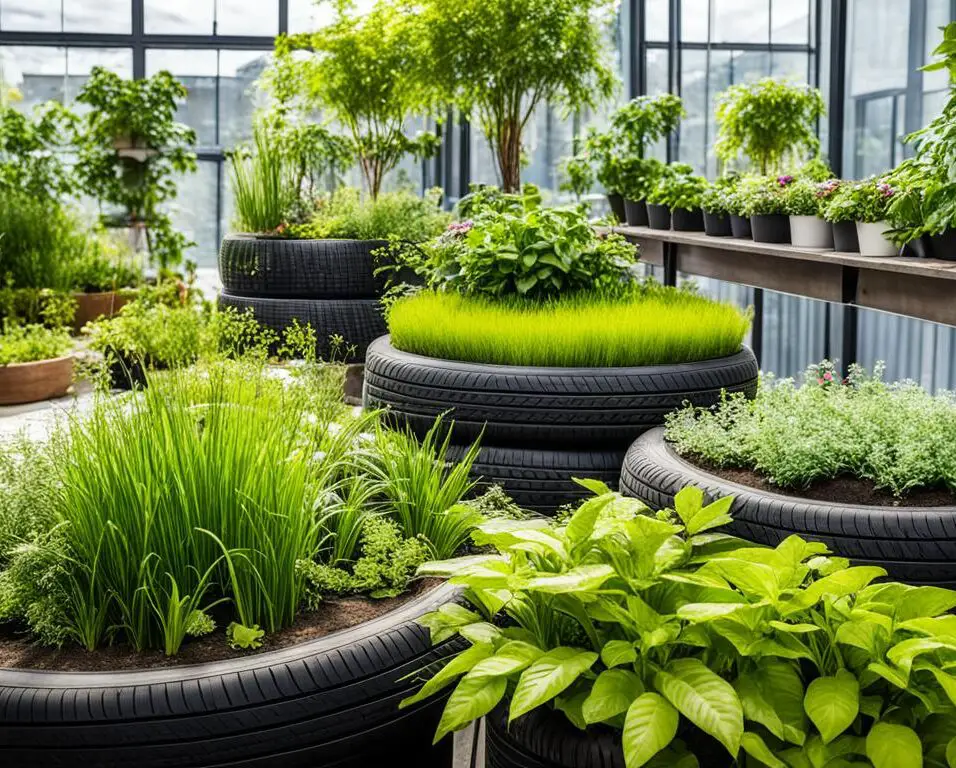The Natural Canvas: The Art of Biophilic Landscape Design
As a landscape designer, I have always been inspired by the beauty and harmony of nature. The art of biophilic landscape design allows me to merge my passion for sustainable design with the integration of nature into our built environment. By creating spaces that are not only visually appealing but also mimic the soothing and revitalizing qualities of the natural world, biophilic landscape design transforms our surroundings into serene and rejuvenating havens.
Biophilic landscape design is a fascinating trend that focuses on incorporating natural elements into our surroundings, blurring the line between indoor and outdoor spaces. By embracing nature-inspired design principles, such as the integration of greenery, natural materials, and natural light, we can create environments that not only promote well-being but also contribute to a more sustainable future.
Imagine a garden filled with lush green walls, a captivating water feature, and an abundance of natural light filtering through the trees. This type of design not only creates a visually stunning space but also evokes a sense of tranquility and connection to the natural world. The integration of nature into our built environment has a profound impact on our physical and mental well-being, reducing stress, improving air quality, and increasing productivity.
Key Takeaways:
- Biophilic landscape design focuses on the integration of nature into the built environment.
- This design approach incorporates elements such as greenery, natural materials, and natural light.
- Biophilic landscape design promotes well-being, reduces stress, and fosters a deeper connection with nature.
- By using sustainable materials and following biophilic design principles, designers can create spaces that are both beautiful and environmentally friendly.
- Biophilic landscape design offers endless possibilities for creating harmonious and nature-inspired spaces.
Embracing Nature: Biophilic Elements in Landscape Design
When it comes to biophilic landscape design, incorporating various elements can create a more natural and inviting space. These biophilic elements not only enhance the aesthetics but also promote a deeper connection with nature and well-being.
1. Living Walls
Also known as vertical gardens, living walls have gained popularity in biophilic design. They provide a lush and green backdrop that improves air quality, reduces stress, and adds visual interest to the surroundings. Living walls bring nature indoors, creating a harmonious and refreshing environment.
2. Green Roofs
Green roofs are another biophilic element that can transform urban landscapes. By introducing more greenery into rooftops, green roofs not only enhance the visual appeal but also provide insulation, reduce stormwater runoff, and promote biodiversity. These rooftop gardens create a seamless integration of nature into the built environment.
3. Water Features
Water features, such as ponds or fountains, add a soothing and calming element to outdoor spaces. Beyond their aesthetic appeal, these biophilic elements create a multisensory experience, with the sound and sight of water instilling a sense of tranquility. Water features also attract wildlife, further enhancing the connection with the natural world.
4. Natural Lighting
Natural lighting plays a crucial role in biophilic design, as it brings the outside in and creates a connection with the natural environment. Maximizing natural light through strategic placement of windows, skylights, and light tubes not only reduces energy consumption but also enhances the occupants’ well-being and productivity by providing a visual connection with nature.
By incorporating living walls, green roofs, water features, and natural lighting, biophilic landscape design creates spaces that evoke a sense of tranquility, promote well-being, and foster a deeper connection with nature.
Biophilic landscape design offers endless possibilities for creating harmonious and sustainable spaces. These elements, when combined with thoughtful design strategies, can transform any environment into a nature-inspired oasis.
Biophilic Materials: Sustainable and Natural Choices
In biophilic landscape design, I prioritize the use of sustainable and natural materials. By choosing materials that have minimal environmental impact, we can create spaces that not only look beautiful but also contribute to a healthier and more sustainable planet.
Sustainable materials are a cornerstone of biophilic design. These materials are sourced responsibly, ensuring that their production and extraction processes have minimal negative impact on the environment. They help us create spaces that align with our values of sustainability and conservation.
Natural materials play a key role in bringing the essence of nature into our designs. The use of natural materials, such as wood, stone, and plant-based fibers, creates a sense of harmony and connection with the natural world. It evokes a feeling of warmth and comfort, making spaces more inviting and soothing.
Reclaimed Wood: Bringing History and Character
One of the sustainable materials that I often incorporate into biophilic designs is reclaimed wood. This material offers a unique combination of sustainability and character, as it is salvaged from old buildings, barns, or other structures. By using reclaimed wood, we not only reduce the demand for new timber but also give new life to materials that would have otherwise gone to waste.
Reclaimed wood brings a sense of warmth, history, and authenticity to spaces, making them feel more grounded and connected to their surroundings. Its unique textures, knots, and imperfections add visual interest and a touch of rustic charm. Whether used for furniture, flooring, or architectural elements, reclaimed wood is a sustainable choice that enhances the beauty and sustainability of biophilic designs.
Recycled Materials: Unleashing Creativity
An important aspect of sustainable biophilic design is the use of recycled materials. These materials are derived from waste or discarded products and transformed into new design elements. By repurposing materials, we reduce the reliance on virgin resources and minimize waste sent to landfills.
Recycled materials, such as glass or metal, can be used to create unique and eco-friendly design elements. From sculptures and art installations to lighting fixtures and furniture, the possibilities are endless. These materials not only add a touch of creativity and innovation to biophilic designs but also contribute to a circular economy where materials are reused and resources are conserved.
Organic Textiles: Sustainable Comfort
When it comes to creating comfortable and sustainable biophilic spaces, organic textiles are an excellent choice. These textiles are made from natural fibers, such as cotton, hemp, or linen, which are grown without the use of pesticides or synthetic chemicals.
Organic textiles bring a sense of softness and coziness to spaces, making them more inviting and comfortable. These textiles are not only gentle on the skin but also have a lower environmental impact compared to synthetic counterparts. By using organic textiles in our designs, we prioritize the well-being of both the occupants and the environment.
Choosing sustainable and natural materials is an essential step in creating biophilic designs that promote well-being and sustainability. By incorporating materials like reclaimed wood, recycled materials, and organic textiles, we can create spaces that not only reflect our connection with nature but also contribute to a healthier planet.
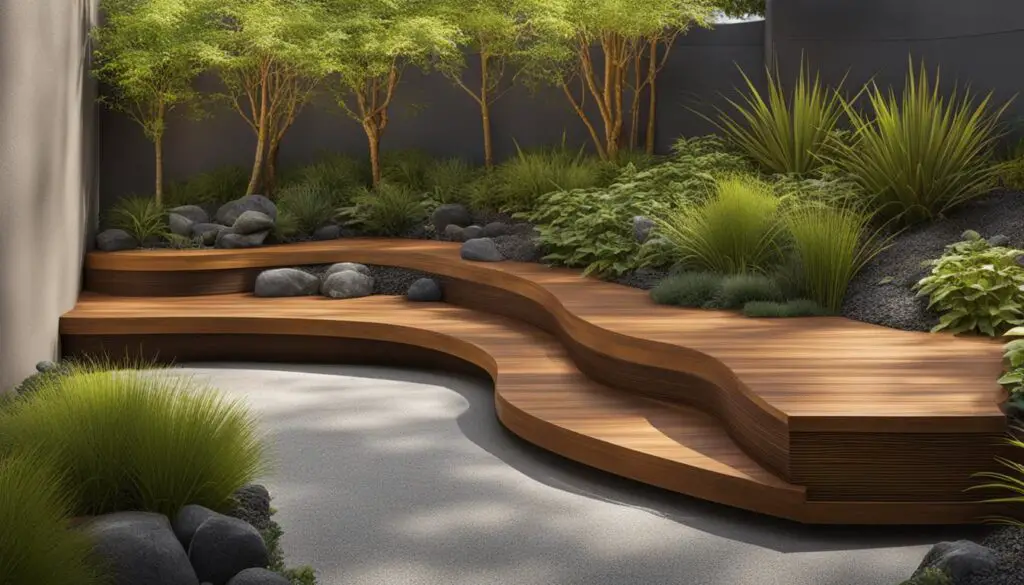
Creating Serene Spaces: Biophilic Design Principles
Biophilic design principles serve as the foundation for creating serene and inviting spaces that foster a deep connection with nature. These principles guide designers in crafting environments that not only enhance aesthetics but also promote well-being and a sense of harmony with the natural world.
One key principle of biophilic design is the incorporation of sensory experiences. By engaging the senses, such as the soothing sound of water or the delightful scent of flowers, designers create a multisensory environment that immerses individuals in the natural world. This connection with nature has been shown to reduce stress, improve mood, and enhance cognitive functions.
Another principle is the use of natural patterns and textures. By incorporating leaf motifs, stone finishes, or other elements inspired by nature, designers mimic the patterns found in the environment. These natural patterns and textures create a visual harmony that resonates with our innate affinity for the natural world.
Spatial layout is also an integral aspect of biophilic design. Open and flowing spaces that allow for a seamless transition between indoor and outdoor areas create a sense of unity with the surrounding environment. This thoughtful spatial arrangement enables individuals to experience a greater connection with nature, leading to increased relaxation and rejuvenation.
By applying these biophilic design principles, designers can create serene spaces that promote well-being and connection with the natural world. Through sensory experiences, natural patterns and textures, and carefully planned spatial layouts, individuals can cultivate a deeper appreciation for their surroundings and experience the many benefits of biophilic design.
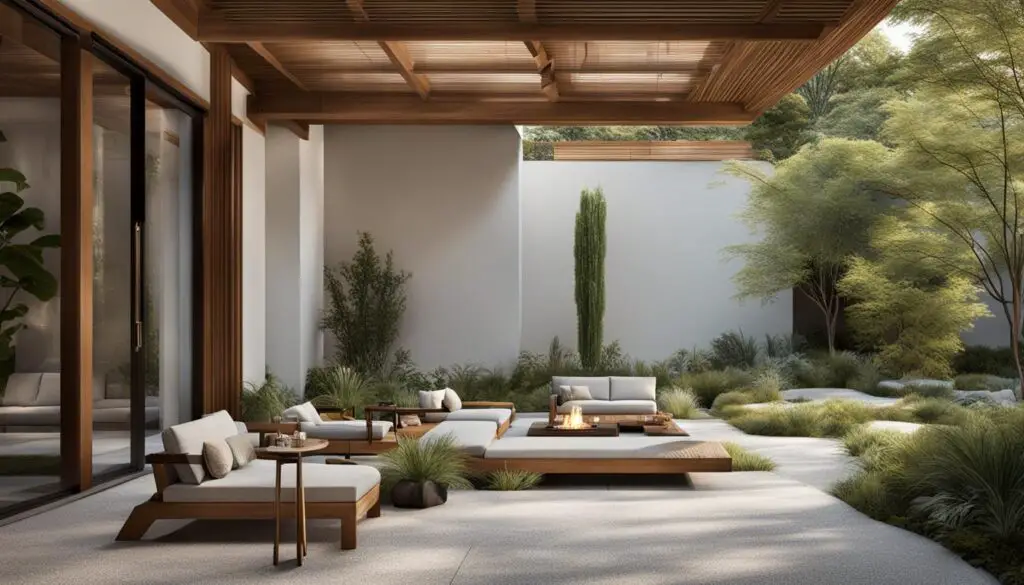
| Principle | Application |
|---|---|
| Incorporation of sensory experiences | Installation of a water feature, such as a bubbling fountain, to provide a calming sound and visual focal point |
| Use of natural patterns and textures | Integration of decorative wall panels with leaf motifs or the use of natural stone veneer for a wall feature |
| Spatial layout | Creation of an open-concept living area that seamlessly blends with an adjacent outdoor terrace |
Conclusion
Biophilic landscape design offers a unique and innovative approach to creating spaces that not only captivate the eye but also foster well-being and a deep connection with nature. By incorporating biophilic elements, using sustainable and natural materials, and following biophilic design principles, designers can transform ordinary spaces into extraordinary nature-inspired sanctuaries.
With biophilic landscape design, we can bring the beauty and benefits of nature into our everyday lives, promoting sustainable living and a profound appreciation for the natural world. Whether it’s a small residential garden or a sprawling public park, biophilic design offers endless possibilities to create serene and harmonious spaces that truly reconnect us with the natural canvas of our surroundings.
By enveloping ourselves in nature-inspired spaces, we can experience the calming and transformative effects that come from a genuine connection with nature. Biophilic landscape design enables us to unleash our creativity and imagination, while also fostering a sense of environmental stewardship. It is a powerful tool that encourages us to prioritize sustainable living and live in harmony with the natural world that surrounds us.
FAQ
What is biophilic landscape design?
Biophilic landscape design is a growing trend in sustainable design that focuses on integrating nature and natural elements into the built environment to create spaces that evoke a sense of tranquility and well-being.
What are some biophilic elements in landscape design?
Some biophilic elements in landscape design include living walls (vertical gardens), green roofs, water features, and natural lighting.
How do living walls contribute to biophilic design?
Living walls, or vertical gardens, provide a lush and green backdrop that improves air quality, reduces stress, and adds visual interest to a space.
What are the benefits of using green roofs in biophilic design?
Green roofs introduce more greenery into urban landscapes, improve insulation, reduce stormwater runoff, and create a connection with nature.
How do water features enhance biophilic design?
Water features such as ponds or fountains add visual interest, create a soothing and calming atmosphere, and contribute to a multisensory environment.
Why is natural lighting important in biophilic design?
Natural lighting helps bring the outside in, creates a connection with the natural environment, and enhances the overall aesthetic of a space.
What materials are commonly used in biophilic landscape design?
Sustainable and natural materials such as reclaimed wood, recycled materials (like glass or metal), and organic textiles (made from natural fibers) are commonly used in biophilic landscape design.
What is the significance of using reclaimed wood in biophilic design?
Reclaimed wood brings a sense of warmth and history to a space, while also minimizing environmental impact by repurposing existing materials.
Why are recycled materials preferred in biophilic design?
Recycled materials are a sustainable choice that can be used to create unique and eco-friendly design elements, contributing to a healthier and more sustainable planet.
What are the benefits of using organic textiles in biophilic design?
Organic textiles, made from natural fibers such as cotton or linen, are comfortable, sustainable, and contribute to a healthier indoor environment.
What are some biophilic design principles?
Biophilic design principles include incorporating sensory experiences, using natural patterns and textures, and creating open and flowing spaces that seamlessly transition between indoor and outdoor areas.
How do sensory experiences enhance biophilic design?
Sensory experiences such as the sound of water or the scent of flowers engage the senses, create a multisensory environment, and foster a deep connection with nature.
Why are natural patterns and textures important in biophilic design?
Natural patterns and textures, such as leaf motifs or stone finishes, mimic the patterns found in nature and create a harmonious and visually appealing atmosphere in biophilic design.
What is the significance of spatial layout in biophilic design?
Spatial layout in biophilic design focuses on creating open and flowing spaces that allow for a seamless transition between indoor and outdoor areas, reinforcing the connection with nature.
What does biophilic landscape design offer?
Biophilic landscape design offers a unique approach to creating visually appealing and functional spaces that promote well-being, sustainability, and a deeper connection with the natural world.
How does biophilic design contribute to sustainable living?
Biophilic design incorporates sustainable elements, materials, and principles, promoting a healthier and more sustainable planet in our everyday lives.
What are the benefits of creating nature-inspired spaces?
Creating nature-inspired spaces through biophilic design promotes well-being, reduces stress, and fosters a deeper appreciation for the beauty and benefits of the natural world.
How does biophilic landscape design connect us with nature?
Biophilic landscape design brings the beauty and benefits of nature into our everyday lives, creating spaces that foster a sense of harmony and connection with the natural canvas of our surroundings.



